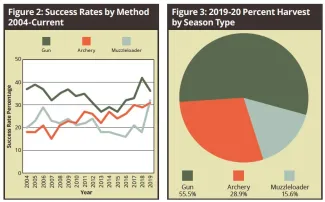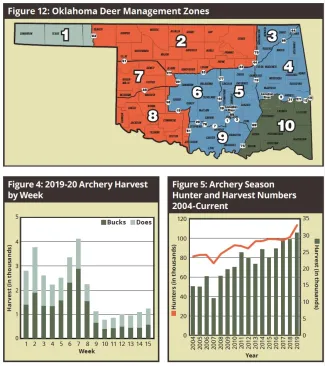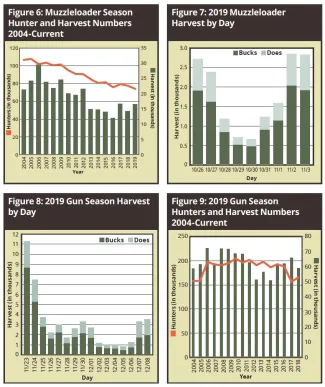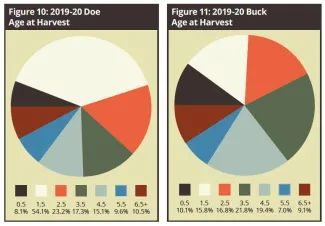With the 2019-20 season in the books, it is clear that Oklahoma hunters are continuing to enjoy a healthy resource in our deer herd. Harvest totaled 106,337 deer, a small decrease from the 2018-19 season. Figure 1 depicts a deer harvest breakdown from 2004 to current. Doe harvest made up for 37 percent of the season total, which is below the target range of 40-45 percent.

Figure 1 from the 2019-2020 Big Game Report depicts a deer harvest breakdown from 2004 to the most recent season.
This marks the fourth year in a row of failing to reach doe harvest goals.
Gun hunting continues to be the most popular method and thus makes up the majority of the total harvest at 55.5 percent. A total of 59,045 deer were harvested during the various gun seasons (youth, regular gun, and holiday antlerless).
Muzzleloader hunting continues to show declining hunter participation. However, for those hunters utilizing this method, harvest and success rates were up compared to the 2018-19 season. Muzzleloader hunters harvested 16,544 deer. Figure 2 shows success rates amongst the various hunting methods.
In contrast, archery hunting continues its long-term growth in the state with a new archery harvest record of 30,748 total deer harvested.
Individual seasons and their respective harvests are represented in Figure 3.

Oklahoma boasts some of the most diverse landscapes in the country. Along with that diversity comes varying quality and amounts of deer habitat. While some counties have wildlife management areas (WMAs), to help even the playing field with those counties that do not, Table 1 reflects deer harvest totals by county with data from the WMAs removed. As always, larger counties top the list. Osage County totaled 4,454 deer harvested, while Creek County landed in second place with 3,038. The third highest total came from McCurtain County with 2,908 deer harvested.

Oklahoma is limited in regards to options for public land hunting as 97 percent of the state is privately owned. However, hunters do have great options on Wildlife Department WMA’s and other public lands. Despite only making up 3 percent of the total acreage in the state, public land made up for 6.4 percent of the total harvest. Details of public land harvest can be seen in Table 2.

Mule deer harvest showed a slight increase this season. As habitat continues to improve in the western portions of the state, increasing mule deer numbers have been reported by Department personnel working in those areas. Table 3 shows mule deer harvest from the 2019-20 season.

ARCHERY SEASON
The 2019-20 Archery season was a record setter in more than one way. First, a record number of participants took to the woods with a bow this year. The Wildlife Departments Game Harvest Survey (GHS) estimated over 113,000 hunters hunted with archery equipment in hand. Second, a new harvest record of 30,748 animals were taken, accounting for 28.9 percent of the harvest. Of the 30,748 deer harvested, 17,945 of them were bucks, and the remaining 12,803 were does. Success rates using archery equipment according to the Game Harvest Survey was 31 percent.
Regulations remained unchanged for the 2019-20 archery deer season, and the season ran from Oct. 1, 2019, through Jan. 15, 2020. The bag limit was six deer, no more than two of which could be antlered. A breakdown of harvest by sex, and week can be seen in Figure 4. Figure 5 depicts hunter numbers and harvest totals from 2004 to this past year.

MUZZLELOADER SEASON
From Oct. 26 through Nov. 3, hunters were allowed to pursue deer using a muzzleloader. Bag limits remained unchanged with hunters having the ability to harvest three deer, with no more than one antlered. Hunters wanting to harvest more than one antlerless deer had to harvest at least one antlerless deer from Management Zones 2, 7 or 8 (refer to the Oklahoma Deer Management Zones map in Figure 12 above.) The annual Game Harvest Survey estimated 74,090 hunters took advantage of this very underutilized method. Harvest totals reached 16,544, which is the second highest total in the last 7 years. Doe harvest totaled 4,942 deer while bucks totaled 11,602 deer. Those deer harvested with a muzzleloader made up 15.6 percent of the total 2019 harvest. A breakdown of hunter numbers and harvest can be found in Figure 6, while a day by day breakdown of harvest by sex can be seen in Figure 7.

GUN SEASON
The 2019-20 gun season opened Nov. 23 and ran for 16 consecutive days ending on Dec. 8. Bag limits remained unchanged from the previous year with hunters having the opportunity to harvest three deer, with no more than one antlered. Hunters wanting to harvest more than one antlerless deer had to harvest at least one antlerless deer from Management Zones 2, 7 or 8. A day-by-day breakdown of harvest is shown in Figure 8. See Figure 12 for Oklahoma’s Antlerless Deer Zones.
The Youth Deer Gun season occurred from October 18th through the 20th. Game Harvest Survey estimated 5,804 youth hunters participated. It resulted in the harvest of 3,920 deer.
The Holiday Antlerless Gun Season gave hunters one final opportunity to reach management goals or fill their freezers. This season started on Dec. 20 and ran for 10 days, ending on Dec. 29. The estimated 39,385 hunters that participated managed to bag 3,758 antlerless deer.
The GHS estimated 165,763 hunters participated in some form of gun season hunting. Hunter numbers and harvest data can be seen dating back to 2004 in Figure 9. In total 59,045 deer were harvested using a modern firearm, making up for 55.5 percent of the total harvest. Of the 59,045 deer harvested, 37,900 were bucks and 21,145 were does.
DEER AGE STRUCTURE 2019-20
Each season, the Oklahoma Department of Wildlife Conservation enlists students from universities across the state to collect deer jaws from taxidermists, controlled hunts and meat processors with the hunter’s approval. These jaws, combined with jaws from Deer Management Assistance Program cooperators and the Age My Deer online submission form, allow biologists to provide an age for that deer. This provides data about harvest pressure as it relates to specific age classes. A breakdown of age classes harvested for does and bucks can be seen in Figures 10 and 11.

ELK
For the sixth season, hunters had the opportunity to harvest elk statewide on private land with written landowner permission, as well as through the Department’s controlled hunt offerings. These private land seasons ran concurrently with open deer seasons, except in the State’s Special Southwest Zone which had its own separate seasons. Hunter efforts during the 2019-20 seasons resulted in 376 elk being harvested across the state, which is down 5 percent from last year. Bulls made up 174 (46%) of harvest, and cows made up the remaining 202 (54%).
The Cookson Wildlife Management Area controlled hunt yielded one bull elk, filing the only allotted tag, while the Wichita Mountains National Wildlife Refuge controlled hunts resulted in 170 elk being harvested, 65 of which were bulls and 118 were cows.
A breakdown of harvest by county, sex and method can be seen in Table 4 below.

PRONGHORN
The Oklahoma panhandle continues to support a population stable enough to allow a hunting season for pronghorn, the fastest land animal in North America. Hunting opportunities included an over-the-counter archery license, Department controlled hunts permits, and landowner drawn permits. All of these opportunities combined for a total of 169 pronghorn being harvested in the open zone which includes Cimarron and the west half of Texas County. Bucks led the harvest total with 88, while doe harvest totaled 81. Hunters toting stick and string managed to harvest 23 pronghorns in Cimarron County and 6 pronghorn in Texas County. The majority of harvest came from rifle hunters which included those lucky enough to draw a once in a lifetime hunt through the controlled hunts program, and landowners awarded with a permit. Texas County accounted for 37 pronghorns harvested, while hunters in Cimarron County harvested 101 with a rifle.
A breakdown of harvest by county, sex, and method can be seen in Table 5.

CONCLUSIONS
Deer hunters in Oklahoma continue to enjoy a healthy deer herd, providing ample harvest opportunity on a statewide basis. Generally speaking, the habitat and herd have both rebounded from drought conditions in the West, and floods throughout the East. Multiple summers with ample rainfall has resulted in growing populations statewide. Fortunately we have implemented a management strategy which allows flexibility to respond to the ebb and flow of deer numbers at a localized level. As hunters begin to show more and more emphasis on harvesting mature bucks, trophy potential is not as handcuffed regionally as in years past. Reports of impressive deer coming from every corner of the state are becoming the norm.
While overall harvest totals were not record setting, we did see a record year for archery hunters in regards to both harvest, and participation. Success rates for both archery, and muzzleloader hunters were at an all-time high.
Oklahoma is unique in both its vast landscapes and its liberal deer hunting opportunities, all while maintaining a healthy buck age structure due to hunters letting younger bucks pass via voluntary restraint. Using science-based regulations and utilizing our hunters as managers, we are constantly working towards our goal of balanced deer herds in comparison to local habitat conditions and healthy age structures. This is imperative for our future generations of both wildlife and hunters alike.
I wish all of you the best in your outdoor endeavors during the 2020-21 seasons. Keep in mind that every time you pull the trigger or let an arrow fly, you are making a management decision that has an impact on that population. Be in the know by letting young bucks grow. Be in the know by harvesting a doe. Do not forget to take someone new to our sport, our hunting heritage depends on it.
The annual Big Game Report is published each year in Outdoor Oklahoma, the official magazine of the Oklahoma Department of Wildlife Conservation. To subscribe for only $10 per year, click the button below.